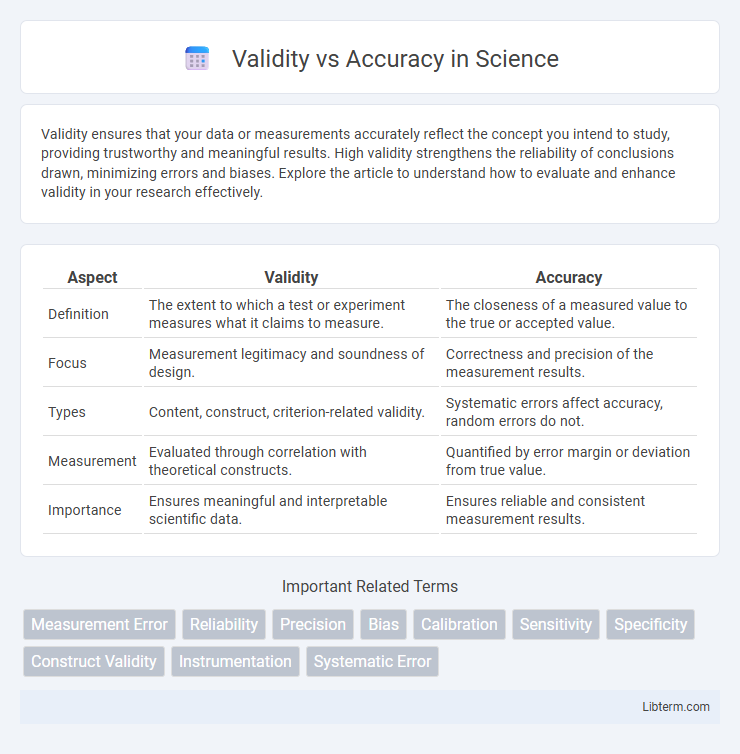Validity ensures that your data or measurements accurately reflect the concept you intend to study, providing trustworthy and meaningful results. High validity strengthens the reliability of conclusions drawn, minimizing errors and biases. Explore the article to understand how to evaluate and enhance validity in your research effectively.
Table of Comparison
| Aspect | Validity | Accuracy |
|---|---|---|
| Definition | The extent to which a test or experiment measures what it claims to measure. | The closeness of a measured value to the true or accepted value. |
| Focus | Measurement legitimacy and soundness of design. | Correctness and precision of the measurement results. |
| Types | Content, construct, criterion-related validity. | Systematic errors affect accuracy, random errors do not. |
| Measurement | Evaluated through correlation with theoretical constructs. | Quantified by error margin or deviation from true value. |
| Importance | Ensures meaningful and interpretable scientific data. | Ensures reliable and consistent measurement results. |
Introduction to Validity and Accuracy
Validity refers to the extent to which a measurement or test truly measures what it is intended to measure, ensuring the results are meaningful and applicable. Accuracy indicates how close a measurement is to the true or accepted value, emphasizing precision and correctness in the data obtained. Understanding the distinction between validity and accuracy is crucial for designing reliable experiments and interpreting results effectively.
Defining Validity: What Does It Mean?
Validity refers to the extent to which a measurement or test truly reflects the concept it is intended to assess, ensuring the results are meaningful and relevant. It evaluates whether the tool captures the intended construct without distortion or bias, distinguishing it from accuracy, which measures how close results are to a true value or standard. High validity confirms that conclusions drawn from data are credible and applicable to the specific research or assessment context.
Understanding Accuracy: Core Concepts
Accuracy measures how close a measurement is to the true or accepted value, reflecting the correctness of the data collected. It involves minimizing systematic errors and ensuring that instruments are properly calibrated to produce reliable results. Understanding accuracy is essential for interpreting experimental outcomes and validating scientific conclusions.
Key Differences Between Validity and Accuracy
Validity measures whether a test or instrument truly assesses what it claims to measure, ensuring conceptual soundness and relevance. Accuracy refers to how close a measurement is to the actual or true value, emphasizing precision and correctness. The key difference lies in validity addressing the appropriateness of the tool or method, while accuracy concerns the exactness of the measurement outcome.
Importance of Validity in Research and Measurement
Validity ensures that research and measurement tools accurately capture the intended concept, making study findings credible and applicable. High validity reduces systematic errors and enhances the interpretability of results, which is crucial for evidence-based decision-making in scientific and practical contexts. Emphasizing validity strengthens the overall quality and trustworthiness of research outcomes, distinguishing it from mere accuracy that only reflects proximity to a true value without guaranteeing meaningfulness.
The Role of Accuracy in Data Collection
Accuracy in data collection ensures that the gathered information closely reflects the true values or conditions being measured, directly impacting the reliability of research outcomes. While validity assesses whether a test measures what it is intended to, accuracy quantifies the correctness of the data obtained during measurement processes. High accuracy reduces errors and biases, enabling precise data analysis and meaningful decision-making in scientific studies and practical applications.
Common Misconceptions: Validity vs Accuracy
Many confuse validity with accuracy, but they represent distinct concepts: validity refers to whether a measurement truly reflects the intended construct, while accuracy indicates how close results are to the true value. A test can be accurate, consistently hitting a target, yet invalid if it measures the wrong attribute. Understanding this distinction is essential in research design and data interpretation to avoid misrepresenting findings.
Practical Examples Illustrating Validity and Accuracy
A thermometer that consistently shows the correct temperature demonstrates both validity and accuracy, while a weighing scale that gives stable but incorrect readings shows high reliability but low validity. For example, a classroom test that aligns with curriculum standards (valid) but has ambiguous questions may produce varied student scores that lack accuracy. In quality control, measuring instruments must be calibrated to ensure measurements are both accurate (close to true value) and valid (suitable for intended use), ensuring reliable product assessments.
How to Improve Validity and Accuracy in Studies
Improving validity in studies involves designing robust methodologies that reduce biases, implementing reliable measurement tools, and ensuring sample representativeness to accurately reflect the target population. Enhancing accuracy requires precise data collection, consistent calibration of instruments, and thorough data validation procedures to minimize errors and increase the reliability of results. Utilizing standardized protocols and conducting pilot tests also contribute significantly to boosting both validity and accuracy in research outcomes.
Conclusion: Striking a Balance Between Validity and Accuracy
Achieving a balance between validity and accuracy is crucial for reliable data interpretation and decision-making. Validity ensures the appropriateness of the measurement, while accuracy reflects the closeness of the results to the true value. Prioritizing both aspects enhances the credibility of research findings and supports robust conclusions in scientific studies.
Validity Infographic

 libterm.com
libterm.com